|
The Double Paradox: Madness in Reason and Reason in Madness
PERIOD 7
Text five: “Sirrah, you were best take my coxcomb” (Act 1, Scene 4, ll. 97-148)
BEFORE READING ACTIVITY
THE FOOL (5 min.)
AIM: to introduce the Fool as a key-character in the play, to learn about the Fool’s function in King Lear , to revise the theatrical convention of “comic relief”.
PROCEDURE: The teacher shows the following picture with the over-head projector and prompts his/her class with the following questions:
1.Who’s this character?
2.What was his function at a king’s court?
3.What’s his function in King Lear?
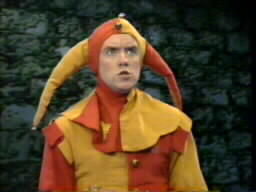
KEYS
1.The Fool.
2.The Fool was kept at a king’s court for amusement.
3.Comic relief.
At this point it may be useful to revise the definition of
comic relief: “comic episodes or interludes, usually in tragedy, aimed to relieve the tension and heighten the tragic element by contrast. If not actually extended into an episode or interlude, the relief may take the form of a few remarks or observation which help to lower the emotional temperature. Good representative examples are Iago’s gulling of Roderigo in Othello, the drunken porter scene in Macbeth, Hamlet’s laconic and witty treatment of Polonius, Rosenktrantz and Guildersten in Hamlet, and the Fool’s mockery in King Lear. Other outstanding examples are to be found in Marlowe’s Doctor Faustus, and Webster’s The Duchess of Malfi and The White Devil.”
Before doing the next activity, it may be useful to teach the word ‘coxcomb’: “a fool's cap, often with a cock's comb attached to the top”. The teacher may use a visual aid to help student figure what a coxcomb is and how it is made (see the picture below).
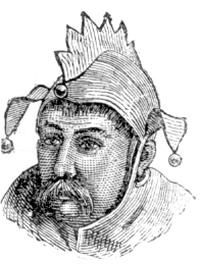
WHILE READING ACTIVITY
A COXCOMB FOR LEAR (25 min. including oral check)
AIM: To analyse the role of the fool in the play, to introduce the double paradox of madness in reason (Lear) and reason in madness (The Fool).
PROCEDURE: The teacher resumes what happens in the first act of the play. He/she may decide to hand out this summary – one per student - so that learners can easily follow the storyline of Act 1:
King Lear wishes to divide his kingdom among his daughters, according to whoever loves him most. Gonerill and Regan speak sycophantically and are rewarded, but his youngest and favourite daughter, Cordelia, refuses to flatter him. Angered by her responses, Lear rejects her and gives her share to her sisters – with whom he now intends to spend his time. Despite Cordelia’s loss of favour, the King of France agrees to marry her, but when Kent defends her, Lear banishes him. Meanwhile, Gloucester’s illegitimate son Edmund is planning to frame his brother Edgar and steal his land; he shows Gloucester a forged letter revealing Edgar’s plans to kill him. At Gonerill’s castle, the new domestic arrangements are not working: Lear and his retinue are accused of being too rowdy, so he departs in a rage for Regan’s palace, along with the Fool and a disguised Kent.
After telling or having one student read out the summary, the teacher hands out the following text and activities. Students work in pairs. The teacher circulates in class, helping as required. After twenty minutes, he/she gets an oral feedback.
Read the text and find out:
1.Why the Fool offers Lear his cap.
2.Why the Fool insults Lear and gets away with it without punishment.
3.Why the Fool pushes Lear to see further what his ego dictates.
4.Why the Fool is a “walking paradox”.
5.What kind of answers the Fool provides.
6.What is tragic about the Fool.
7.What sort of language the Fool uses.
8.What is the tone of Fool’s speeches (tick the adjective that best defines the Fool’s tone)
a. amusing b. sardonic c. grotesque d. funny
KEYS
1.The Fool offers Lear his cap to point out his foolishness for having given his kingdom away before time.
2.Because he is a Fool. In the courts of England, a fool was a comic figure with a quick tongue who entertained the king, the queen and their guests. He was allowed to – even expected to- criticize anyone at court.
3.Because Lear is not able to see the truth. The Fool realizes what Lear can’t or doesn’t want to realize.
4.Because he is the wisest character in the play.
5.The Fool provides answers that are deep in their meaning, but also simple sounding, like a joke or something of the sort.
6.The Fool is the only one who says things that make some sense. The problem is, nobody really listens to him.
7.A figurative language.
8.Sardonic.
---
FOOL
Sirrah , you were best take my coxcomb.
KENT
Why, Fool?
FOOL
Why? For taking one's part that's out of favour.
Nay , and thou canst not smile as the wind sits ,
thou'lt catch cold shortly. There, take my coxcomb:
why, this fellow has banished two on's daughters,
and did the third a blessing against his will . If
thou follow him, thou must needs wear my coxcomb.
How now, nuncle ! Would I had two coxcombs and two daughters!
KING LEAR
Why, my boy?
FOOL
If I gave them all my living, I'd keep my coxcombs
myself . There's mine; beg another of thy daughters.
KING LEAR
Take heed , sirrah, the whip !
FOOL
Truth's a dog must to kennel ; he must be whipped
out, when the Lady Brach may stand by the fire and stink .
KING LEAR
A pestilent gall to me!
FOOL
Sirrah, I'll teach thee a speech.
KING LEAR
Do.
FOOL
Mark it, nuncle:
Have more than thou showest,
Speak less than thou knowest,
Lend less than thou owest ,
Ride more than thou goest,
Learn more than thou trowest ,
Set less than thou throwest ;
Leave thy drink and thy whore
And keep in-a-door ,
And thou shalt have more
Than two tens to a score .
KENT
This is nothing, fool.
FOOL
Then 'tis like the breath of an unfee'd lawyer; you
gave me nothing for't. Can you make no use of
nothing, nuncle?
KING LEAR
Why, no, boy. Nothing can be made out of nothing.
FOOL
[To KENT] Prithee, tell him, so much the rent of
his land comes t. He will not believe a fool.
KING LEAR
A bitter fool!
FOOL
Dost thou know the difference, my boy, between a
bitter fool and a sweet one?
KING LEAR
No, lad ; teach me.
FOOL
That lord that counsell'd thee
To give away thy land,
Come place him here by me,
Do thou for him stand.
The sweet and bitter fool
Will presently appear:
The one in motley here,
The other found out there.
KING LEAR
Dost thou call me fool, boy?
FOOL
All thy other titles thou hast given away; that
thou wast born with.
AFTER READING ACTIVITIES
1) SO MUCH TRUTH BEHIND THOSE RIDDLES (15 min.)
AIM: to analyse the Fool’s speeches and guide students towards a deeper understanding of the text; to explore the theme of truth vs. flattery. PROCEDURE: The teacher gets the class to work in pairs, prints out the handout below and gives copies to his/her students. The teacher circulates, helping as required. After ten minutes, he/she proceeds with oral check.
Mark the following sentences as True or False. Correct the false ones.
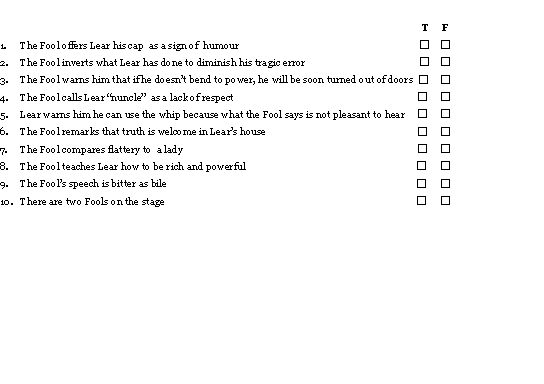
KEYS
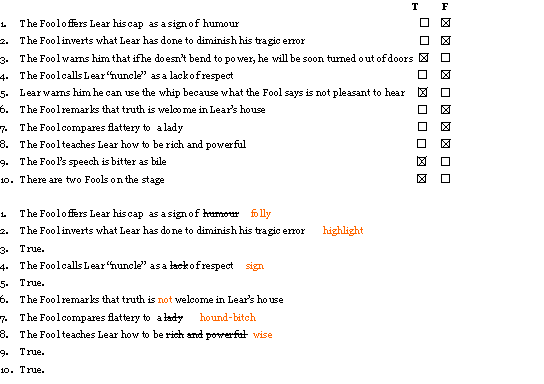
2) MUTUAL DICTATION: THE FOOL (10 min.)
AIM: To expand students’ knowledge about the jester-at-court and his role in Shakespearean drama, to engage students in a motivating writing and listening activity, to develop their ability to “think, pair, share”(cooperative learning). PROCEDURE: The teacher prints out the five mutual dictation handouts below, sets up five mixed ability groups in the class and gives each group one copy of the handouts. When combined, these handouts form a set of notes. Students must start with the group who has the first word on the page (in this case Group 1). One of the group members reads a set of words, which is copied down by each member of the class. This group is followed by the group who has the second set, and so on. Once somebody has read a set, they must pass the page to the person beside them. This ensures that everyone keeps up with the notes and that the groups are not dominated by one or two people. It sounds chaotic, but it works well. Students must concentrate on their listening skills as well.
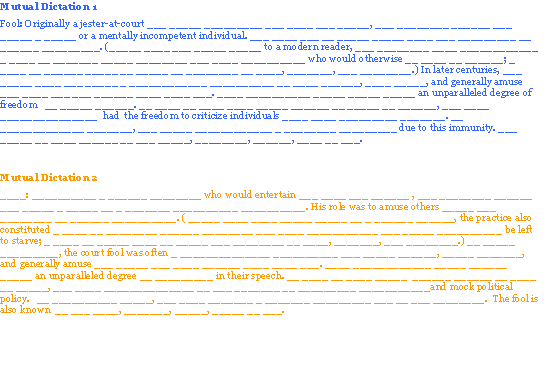
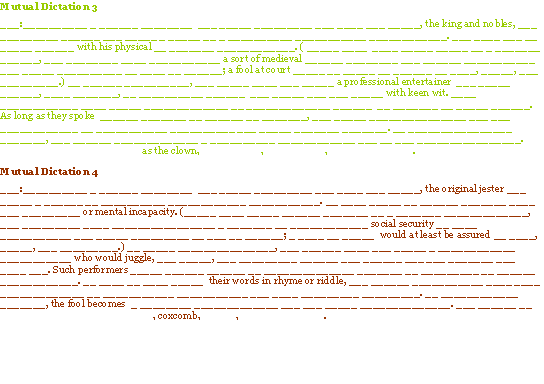
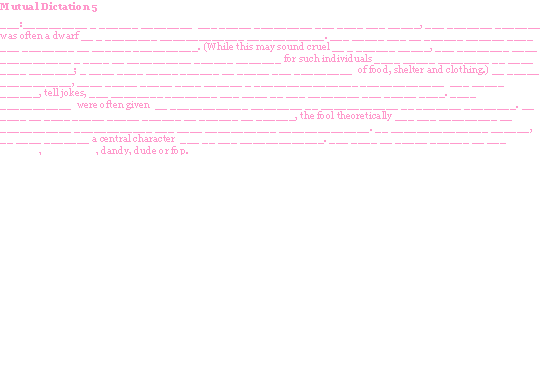
KEYS
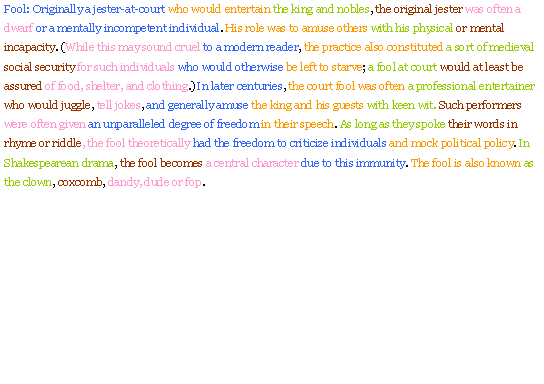
 7/11
7/11

|